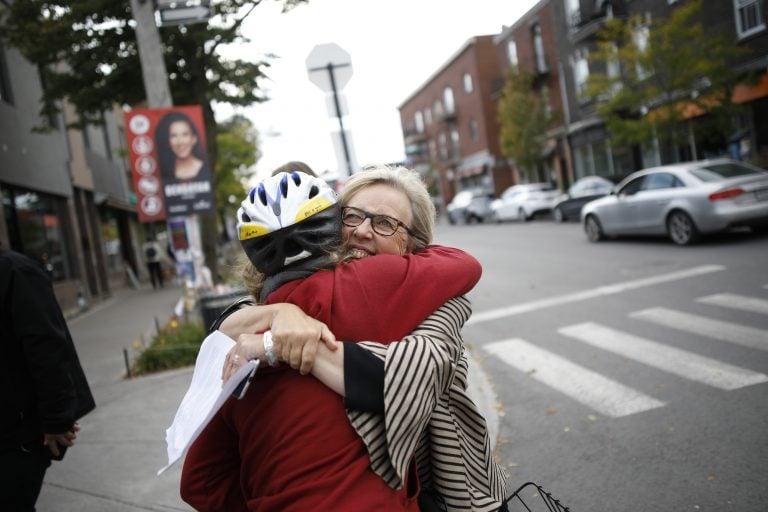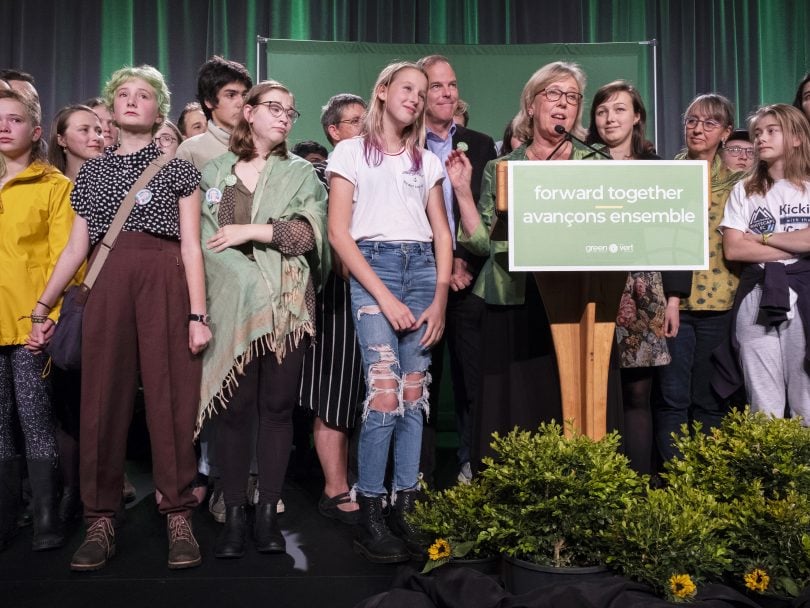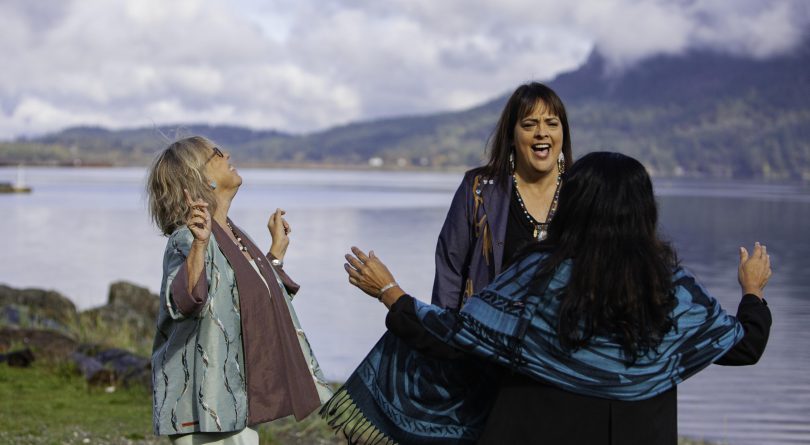If only hugs were votes
Against the backdrop of widespread climate concern, this federal election was supposed to be the Greens’ breakout. What happened?

May during an election campaign visit in Montreal, on Oct. 9, 2019. (Photograph by Blair Gable)
Share
“Mother Earth is here,” a Green party supporter declared as Green Leader Elizabeth May walked into the Crystal Garden, at the Victoria Conference Centre, before election results for most of the country started to flow on election night. A spirit of jubilation reigned at the time. Green candidate Jenica Atwin had just been declared the winner in Fredericton, a formerly Liberal riding. It was a big breakthrough: the third Green MP elected, and the first elected beyond Vancouver Island. The island was seen as ground zero for Green party gains this election but, as the evening progressed, hoped-for wins didn’t materialize. The Greens reclaimed the two seats they’d held of the island’s seven: May handily won Saanich—Gulf Islands, the riding she has represented since 2011; Paul Manly won more narrowly in Nanaimo-Ladysmith, where he’d prevailed in a by-election earlier this year. The five other ridings were won by the NDP. John Kidder, May’s husband of six months, placed fourth in Mission—Matsqui—Fraser Canyon, a riding won by Conservatives.
This federal election was supposed to be the Greens’ breakout. The portents were there—hundreds of thousands of Canadians marching in climate strikes to protest government inaction, inspired by 16-year-old Greta Thunberg and a world melting, burning and flooding. In 2018, the UN Intergovernmental Panel on Climate Change (IPCC) warned that governments had 12 years to cut carbon output significantly; a 2019 federal government climate report warned that Canada is warming twice as fast as the global average. Provincial Greens were making breakthroughs—in B.C., where they hold the balance of power; in P.E.I., where Greens form the official opposition; and in Ontario and New Brunswick—inroads that directed the Greens’ federal campaign. Spirits were so high, the prospect of the Greens eclipsing the NDP was even floated. April numbers from EKOS pollster Frank Graves saw the Greens ahead of the NDP for the first time in 20 years: “Greens were at 14 with the NDP 1.5 points back,” Graves told Maclean’s, noting his previous polling never saw the Greens higher than 10 per cent.
READ: The climate wars will be waged in middle-class living rooms
But an election May called a “referendum on the climate crisis” would in fact train a spotlight on the political obstacles the nation faces in addressing it. Climate was predicted to be a key electoral issue, but discussions about keeping global temperature to 1.5 C warming were scant. The race was riddled with false information, scare tactics, negativity and scandals big and small. The Greens weren’t exempt. The party had to dial back a party spokesperson’s comment that national unity wasn’t a “core value.” A Green staffer digitally altered a plastic, recyclable cup May held in a photo with an eco-friendlier Green party mug: “It was stupid,” May says. May would be the lone climate Cassandra, proclaiming that Canada had to reduce greenhouse gas emissions to 60 per cent below 2005 levels by 2030 to prevent runaway global warming, double what the Liberals and NDP proposed. The Liberals presented themselves as climate champions, but, as May repeatedly reminded voters, they had kept the Harper government’s climate targets, broken a promise to end fossil fuel subsidies, and spent $4.5 billion on the Trans Mountain Pipeline. The Conservatives’ climate policy was non-existent; it promised to scrap the carbon tax, would increase CO₂ emissions, and had no stated targets.
May uttered her complaints when she had the mike, which wasn’t often, given the media focus on the familiar Big Three throughout the campaign. May, who had the most experience of any party leader, was sidelined, shut out of the TVA debate. The fact she is roundly praised for her civility in the House and her effectiveness as a parliamentarian, and repeatedly named most “trusted” party leader in polls, didn’t count for much. Nor did the fact that May put a party without the 12 seats needed for official party status on the political map. What matters in politics is power, and power is something the grassroots Greens, with their call for collaboration, find problematic. Partisan politics is antithetical to the sort of co-operation necessary to fight climate change, Greens say.
Elizabeth May has been Canada’s most reluctant, confounding politician since 2006, when she was elected leader of the federal Greens. The party May joined was riven by internal debates over whether it was a political party or a movement. May, a lawyer, had a foot in both camps—as a former policy adviser to the minister of the environment in the Mulroney government, and a life-long environmental activist who headed the Sierra Club of Canada. It took May five years to win a seat in the House of Commons; she was the first Green elected in North America. But the successful growth of some 80 Green parties worldwide has hinged on proportional representation voting systems, where the number of seats a party holds mirrors the popular vote. Trudeau’s broken electoral reform promise was a major blow to the Greens, whose popular support of 6.4 per cent this election is up from 3.4 per cent in 2015. Under proportional representation, the newer percentage would have translated into 21 seats. First-past-the-post fosters strategic voting for the lesser of two evils, or, as May liked to put it, “the evil of two lessers.”
May brandishes disdain for party politics as a badge of honour. She decries the control held over MPs by backroom spin doctors and party leaders whipping votes. The Greens like to see themselves as dolphins among sharks; when former Liberal strategist Warren Kinsella, known as a cutthroat operative and Trudeau critic, was hired to consult early on, there was an outcry in and outside the party, and Kinsella was dropped. May downplays the furor. Kinsella’s firm was hired only to expand the Greens’ quick-response capacity, she says.
May’s willingness to draw outside partisan lines can be puzzling to some. That was seen when May spoke at a rally for her friend Jody Wilson-Raybould, running as an Independent in Victoria Granville, where the Greens ran a candidate. Wilson-Raybould returned the favour last weekend at a Green rally, where David Suzuki also spoke. When TV screens at the Victoria conference centre declared Wilson-Raybould the winner of her riding on Monday night, the gathering cheered loudly. “We share the same values,” May said at the end of the evening.
Of course, you can’t change the world without some political traction. But the Greens don’t always see it that way. Throughout election night there were cheers when Greens placed second, as a sign of future momentum. “Winning is not the goal,” a Green supporter said in Sidney, B.C., within May’s own riding. “Greens are in it because they don’t have any other choice. The ship is sinking.”
Walking with May through the Vancouver airport in early October, people repeatedly approach her to say “thank you” and offer encouragement. Many Canadians like the idea of Elizabeth May—her frankness, her non-conformity to political mores, and her tireless, informed, quixotic quest to save the planet. Standing in line for the flight to Victoria, a woman spontaneously hugs her. If hugs were votes, Elizabeth May would be prime minister.
May is headed to her home riding for four 15-hour days of campaigning—door-knocking, all-party debates, rallies and press conferences. It’s all to try and draw attention to the Greens’ ambitious, wildly idealistic and far-ranging 85-page platform, Mission: Possible, a manifesto that would meet with approval from Bernie Sanders. There are sections on shifting to a “green economy” and ending fossil fuel reliance, others on renewing the “social contract” via an initiative that includes universal child care and pharmacare, a guaranteed living income, and free post-secondary tuition. The Greens also promised to balance the budget in five years by taxing the rich and corporations such as Google, Facebook and Netflix. Kevin Page, the former parliamentary budget officer who now heads the Institute for Fiscal Studies and Democracy at the University of Ottawa, reviewed the parties’ “costed platforms.” He initially gave the Greens a “fail,” which made headlines. After the party made adjustments and resubmitted, the institute’s passing grade in three out of four categories didn’t receive much ink.
On the ground, homespun austerity prevails. May and her assistant are driven around by a friend in May’s old silver Prius with a “proportional representation” bumper sticker. When news breaks that the Liberal campaign is using two planes, May cracks that she has a backup electric car, a loaner Tesla. May’s beloved Havanese, Xo, often travels with her.
A series of all-candidate debates in Saanich—Gulf Islands provides a reminder that elections are driven by personal and local concerns: in Saanich—Gulf Islands, that’s a lack of doctors, poor transportation systems and affordability. May herself rents an apartment in Sidney: “I can’t afford to buy,” she shares. On Vancouver Island, the climate crisis is a local concern. At a debate on remote Saturna Island, resident Priscilla Ewbank recalls a terrifying gale storm that took down the electricity. “We’re acutely aware of our fragility, of what it feels like being isolated,” she tells Maclean’s.

Election 43 also saw a battle for the “progressive” vote that got down and dirty between the Greens and NDP. As May put it to Maclean’s on election night, the NDP “spent hundreds of thousands of dollars in disinformation campaigns targeted only at Vancouver Island seats—radio ads, multiple flyers, including to my own home.” May is referring to the NDP working to discredit the Greens. In an interview May gave Power & Politics, she was asked for her stance on abortion. “A woman has a right to a safe, legal abortion,” May said. “I have never wavered from that view since I was eight years old.” When asked if she’d intervene if a Green backbencher introduced a private member’s bill that could reopen the abortion debate, May said she didn’t have the power as Green leader to whip votes or to silence an MP, adding, “and frankly that’s a good thing.” The spectre of the party reopening the debate became a headline after the discovery of fringe Green candidates who had expressed anti-abortion views in the past. The NDP exploited the controversy: Singh attacked May during debates, and the party distributed pamphlets in south Vancouver that claimed the Greens were in cahoots with the Conservatives. May spoke angrily of being “smeared by NDP literature based on untruths” but kept to the “high road,” as she put it. She limited her counterattack to criticism of the NDP’s inability to achieve IPCC targets, a rebuke that predictably failed to generate headlines. The NDP also sent out flyers falsely saying the Greens had flunked Kevin Page’s review; May appeared in a video to correct the record. On election night, as the NDP won ridings that had skewed Green when the writ was dropped, May pointed to the political brinksmanship she called “fake news”: “We faced obstacles we never thought we would face.”
On the campaign trail, May repeatedly expressed frustration that important issues weren’t being discussed. She bemoaned a lack of discussion about IPCC targets with an earnestness that suggested denial of how elections are run. “Even though we think climate is a key issue, we haven’t had a single, sensible, real discussion of climate science and what’s required,” she said in October. Speaking with urgency, she said: “We are out of time for incremental measures. If we don’t achieve IPCC targets, human civilization starts to collapse.”
The Greens’ platform extended far beyond confronting the climate emergency; it ran the gamut from thoughtful and nuanced to being dismissed as too “out there.” The party proposed reviewing the tax system for the first time since the ’60s to make it equitable and progressive, and creating a multi-party “war cabinet” to address the climate crisis. A “robot tax,” a levy on corporations that replace workers with machines, was seized on for ridicule. “We’re not proposing an imminent robot tax—and Bill Gates named it the robot tax, by the way,” May told Maclean’s. “But thinkers are looking ahead to what the world of AI and automation might really mean. People glom onto it and say, ‘This proves they’re nuts.’ I say, ‘Wait a minute. It’s a serious conversation we should be having.’”
But there was little serious conversation these last months. Instead, much to May’s chagrin, the campaign often read as a masculinity contest—literally showcasing strength and vigor. After Singh wielded a huge hammer to ring a bell at a Poutine Fest in B.C., Burnaby Now enthused: “He’s flexing his campaign muscles.” Scheer posed with a baseball bat. Trudeau ran up Grouse Mountain and returned to the boxing ring the morning of the TVA debate. “I have experienced sexism in this campaign a lot,” May says, noting that the presence of more women leading parties would change the dynamic. May bristles at comments that “Greens aren’t ready for prime time”: “I say: ‘Wait a minute. I have more experience than any federal leader.’” Yet the mindset exists. “Until very recently, it was hard to take the Green party, or Elizabeth May, seriously,” Globe and Mail columnist John Ibbitson wrote in September.
“More women political party leaders at the same time would make a big difference,” she says.
By the time May spoke in Victoria on election night—after Singh, Scheer and Trudeau had all delivered their speeches—the crowd had thinned markedly. May stood on the stage, surrounded by young climate activists, many of them crying in disappointment. “They don’t believe the people of Canada care about their future,” May said afterwards. She said she told them that politics is complicated, and people voted believing what the candidates said. May extracted the positive: the doubling of the popular vote, that two of the three-person Green caucus is female, that the Greens put in a record performance in a first-past-the-post election. She promised to hold the government’s “feet to the fire”: “There will be crispy toes.” Later, in a media scrum, May noted that the minority Liberal government could dissolve within months. May often cites the landmark pieces of legislation passed by the minority Liberal government led by Lester B. Pearson in the early 1960s, including universal health care. But during the campaign, the Green leader made it clear her commitment to pan-partisan co-operation doesn’t necessarily extend to a Green coalition. Green priorities in any coalition would be climate, electoral reform and reconciliation, May has said. Yet she rejected the idea of co-operating with any government that doesn’t share Green targets. On the campaign trail, she spoke of Trudeau’s “betrayal” for abandoned promises that the 2015 election would be the last first-past-the-post election, and that the Liberals would be climate leaders. May’s exchange with Trudeau at the commission’s English-language debate on Oct. 8 suggested fracture: “It’s so heartbreaking for me to look at you today and know that you could have done so much more the last four years. Please God you don’t get a majority this time around because you don’t keep your promises.”

How gargantuan the Greens’ mission was this election was poignantly laid bare at a lonely press conference in early October on the shore of Cowichan Bay. May was there to outline the party’s plans for reconciliation with Indigenous people. Maclean’s was the only media present. As the early morning mist lifted, a Green staffer set up a video camera and a Green party scrum. Candidate Racelle Kooy, running in Victoria, and Lydia -Hwitsum, a citizen of the Cowichan Nation running for the Greens in Cowichan-Malahat-Langford, were on hand. Buffy Sainte-Marie and Tanya Tagaq’s You’ve Got to Run (Spirit of the Wind) began playing on a car’s CD player and Kooy, Hwitsum and May danced together, a moment of spontaneous joy and laughter. May’s address outlined the plan for Indigenous communities to opt out of what she called the “racist and oppressive” Indian Act. It also addressed the intersecting structural forces underlying violence against women, among them poverty, inadequate public transportation and unaffordable housing. Afterwards, May stood alongside Kooy, -Hwitsum and Cowichan Elders Dora Wilson and Wilson Daniels Sr. for a photograph. Against the vast backdrop of forest, mountains, sea and sky, they looked so small, their mission so big. So big.
This article appears in print in the December 2019 issue of Maclean’s magazine with the headline, “If only hugs were votes.” Subscribe to the monthly print magazine here.